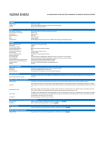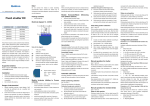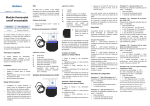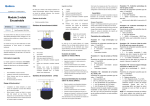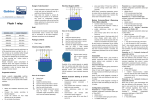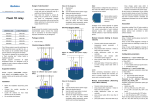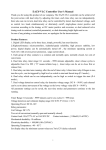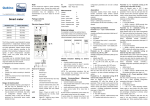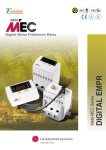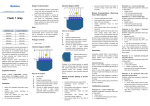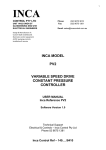Download Manual Qubino Flush Shutter
Transcript
Qubino The INNOVATIVE and SMALLEST Package contents Module Exclusion/Reset from Z-Wave network) Flush shutter Electrical diagram 230VAC Flush shutter ORDERING CODE Z-WAVE FREQUENCY ZMNHCA2 868,4 MHz ZMNHCA3 921,4 MHz ZMNHCA4 908,4 MHz ZMNHCA5 869,0 MHz ZMNHCA6 916,0 MHz Flush Shutter module is used to control the motor of blinds, rollers, shades, garage doors, gates, venetian blinds (including slates tilting positioning), etc… The module can be controlled either through a Z-Wave network or through the wall switch. Precise positioning is supported for motors equipped with mechanical or electronic end switches. The module is designed to be mounted inside a “flush mounting box”, hidden behind a traditional wall switch. Module measures power consumption of motor and support connection of digital temperature sensor. It is designed to act as repeater in order to improve range and stability of Z-wave network. Before the installation disconnect power supply. Connect the module according to electrical diagram. Locate the antenna far from metal elements (as far as possible). Do not shorten the antenna. Danger of electrocution! Module installation requires a great degree of skill and may be performed only by a qualified and licensed electrician. Even when the module is turned off, voltage may be present on its terminals. Any works on configuration changes related to connection mode or load must be always performed by disconnected power supply (disable the fuse). Connect module to power supply bring module within maximum 1 meter (3 feet) of the main controller, enable add/remove mode on main controller, press service button S for more than 6 second or press push button I1 five times within 3s (5 times change switch state within 3 seconds) in the first 60 seconds after the module is connected to the power supply. By this function all parameters of the module are set to default values and own ID is deleted. If service button S is pressed more than 2 and less than 6 second module is excluded, but configuration parameters are not set to default values. Associations N Neutral lead L Q1 Live lead Output for motor UP (open) Q2 I2 Output for motor DOWN (close) Input for switch/push button DOWN (close) I1 TS Input for switch/push button UP (open) Terminal for digital temperature sensor (only for Flush shutter module compatible digital temperature sensor, which must be ordered separately). S Service button (used to add or remove module from the Z-Wave network). Module supports mono-stable switches (push button) and bi-stable switches. Notes for the diagram: Supported switches Installation (Removing Association enables Flush shutter module to transfer commands inside Z-wave network directly (without main controller) to other Z-Wave modules. Associated Groups: Group 1: basic on/off (triggered at change of the input I1 state and reflecting its state) up to 16 nodes Group 2: basic on/off (triggered at change of the input I2 state and reflecting its state) up to 16 nodes Group 3: multilevel (triggered at changes of value of the Flush shutter position) up to 16 nodes. Group 4: multilevel (triggered at changes of value of slats tilting position) up to 16 nodes. Group 5: default reporting group (reserved for the main controller) Automatic calibration Durability of the device depends on applied load. For resistive load (light bulbs, etc.) and 4A current consumption of each individual electrical device, the durability exceeds 70.000 switches of each individual electrical device. Module Inclusion (Adding to Z-wave network) Connect module to power supply (with temperature sensor connected - if purchased), bring module within maximum 1 meter (3 feet) of the main controller, enable add/remove mode on main controller, auto-inclusion (30 minutes after connected to power supply) or press service button S for more than 2 second or press push button I1 three times within 3s (3 times change switch state within 3 seconds) Automatic calibration is a process during which the Flush shutter learns the position of the limit switches. Shutter positioning calibration (par. 71 set to 0) There are two procedures of calibration. Calibration through main controller UI 1) Include the module into the Z-wave network, according to module inclusion instructions. 2) Set the parameter 78 (Forced Flush shutter calibration) value to 1. 3) Flush shutter performs the calibration process, completing full cycle - up, down and up again. 4) Set the parameter 78 (Forced Flush shutter calibration) value to 0. Calibration through the switch keys (I1, I2) 1) Include the module into the Z-Wave network, according to module inclusion instructions. 2) Quick press the switch key connected to I1 input and wait until the shutter reach upper limit switch 3) Quick press the switch key connected to I2 input and wait until the shutter reach lower limit switch 4) Quick press the switch key connected to I1 input and wait until the shutter reach upper limit switch Slates tilting position calibration (par. 71 set to 1) When enabling venetian blind mode, beside position calibration also slats tilting calibration must be done. After that, blind position and angle of slates can be set. By default full turn for slates is set to 1,5s. This value can be changed according to slates types and time by set value in parameter 72. 1) Include and calibrate module according to section ‘Shutter positioning calibration’ 2) Set parameter 71 to 1 ‘Venetian blinds’ 3) Reconfigure node using main controller 4) After module reconfiguration beside main shutter widget, another widget for slates control will appear on UI. 5) Repeat ‘Shutter positioning calibration’ 6) By default full turn movement is set to 1,5s. If this time is too long (after slates full cycle shutter starts moving up or down), decrease this time defined with parameter 72. Manual operation for shutter (par. 71 set to 0) Module allows connecting of push buttons (mono stable) or switches (bi stable) to I1 and I2 terminals. Clicking up button (<2s) connected to I1, initiates up movement. Clicking down button (<2s) connected to I2, initiates down movement. If the shutter is moving, each click, of any button, will stop the movement. Keep pressed button (>2s) connected to I1, initiates up movement until the button is released. Keep pressed button (>2s) connected to I2, initiates down movement until the button is released. Manual operation for venetian blinds (par. 71 set to 1) Slates on start position Clicking up button (for time < full turn slate time-par.72) connected to I1, initiates turning slates into stop direction until the button is released. Clicking down button (for time < full turn slate time-par.72) connected to I2, shutter initiates down movement. If the shutter is moving, each click, of any button, will stop the movement. Slates on end position Clicking up button (for time < full turn slate time-par.72) connected to I1, shutter initiates up movement. If the shutter is moving, each click, of any button, will stop the movement. Clicking down button (for time < full turn slate time-par.72) connected to I2, initiates turning slates into start direction until the button is released Keep pressed button (for time > full turn slate time-par.72) connected to I1, initiates full turn slate and up movement until the button is released. Keep pressed button (for time > full turn slate time-par.72) connected to I2, initiates full turn movement and down movement until the button is released. Configuration parameters Parameter no. 10 - Activate/deactivate functions ALL ON / ALL OFF Available configuration parameters (data type is 2 Byte DEC): default value 255 255 - ALL ON active, ALL OFF active. 0 - ALL ON is not active ALL OFF is not active 1 - ALL ON is not active ALL OFF active 2 - ALL ON is not active ALL OFF is not active Module responds to commands ALL ON / ALL OFF that may be sent by the main controller or by other controller belonging to the system. Parameter no. 40 - Power reporting in Watts on power change for Q1 or Q2 Set value means percentage, set value from 0 – 100 = 0% - 100%. Available configuration parameters (data type is 1 Byte DEC): default value 1 0 – Reporting Disabled 1 – 100 = 1% - 100% Reporting enabled. Power report is send (push) only when actual power (in Watts) in real time changes for more than set percentage comparing to previous actual power in Watts, step is 1%. NOTE: if power changed is less than 1W, the report is not send (pushed), independent of percentage set. Parameter no. 42 – Power reporting in Watts by time interval for Q1 or Q2 Set value means time interval (0 – 32767) in seconds, when power report is send. Available configuration parameters (data type is 2 Byte DEC): default value 300 (power report in Watts is send each 300s) 0 – Reporting Disabled 1 – 32767 = 1 second – 32767 seconds. Reporting enabled, power report is send with time interval set by entered value. Parameter no. 45 - Self-measurement Module may include power and energy used by module itself in reports sent to the main controller. Available configuration parameters (data type is 1 Byte DEC): default value 0 0 - Self-measurement disabled 1 - Self-measurement enable Parameter no. 71 – Operating modes This parameter defines selection between two available operating modes. Configuration parameters (data type is 1 Byte DEC): default value 0 0 – Shutter mode 1 – Venetian mode (up/down and slate rotation) NOTE: After setting parameter, module needs to be reconfigured! Please check detailed description in this manual. Parameter no. 72 – Slats tilting full turn time This parameter defines the time necessary for slats to make full turn (180 degrees). Configuration parameters (data type is 2 Byte DEC): default value 150 (1,5 seconds) 0 – Tilting time disabled 1 – 32767 = 0,01seconds – 327,67 seconds NOTE: If time set is too high, this will result that after full slats turn, shutter will start move up or down, for time remaining. Parameter no. 73 – Slats position This parameter defines slats position after up/down movement through UI or push buttons. Configuration parameters (data type is 1 Byte DEC): default value 2 0 1 0 - Slats return to previously set position only in case of UI control. 1 - Slats return to previously set position in case of UI control, push button operation or when the limit switch is reached. 2 - Slats return to previously set position in case of UI control, push button, when the limit switch is reached or after receiving a “STOP” control frame (Switch Multilevel Stop Level Change) from UI. Parameter no. 74 – Motor moving up/down time This parameter defines shutter motor moving time for complete opening or complete closing. Available configuration parameters (data type is 2 Byte DEC): default value 0 0 – moving time disabled (working with limit switches) 1 – 32767 = 0,1seconds – 3276,7seconds After that time motor is stopped (relay goes to off state) Set parameter 74 to 0 and move the shutter (using up/down push buttons or main controller UI) to desired lower position. On this shutter position, set parameter 74 to time for complete opening or complete closing. At this point shutter can be moved up (open) for set time, but can't be moved down because this position is already set as lower shutter position. To change shutter lower position below already set (manual recalibration), parameter 74 must be set to 0 and repeat the procedure described above. In case shutter has limit switches, but anyhow you would like to limit opening/closing position by time, you can still do it. In case you put time that is longer that opening/closing real time limited by limit switches, shutter will stop at limit switch, but the module relay will switch off after define time, not by shutter limit switch. Take in consideration that in this condition, the positioning with slider through UI will not show correct shutter position. Parameter no. 76 - Motor operation detection Power threshold to be interpreted when motor reach the limit switch. Available configuration parameters (data type is 1 Byte DEC): default value 10 (10W). Available settings: 0 - 127 (0-127 W) Note: The value 0 means reaching a limit switch will not be detected Parameter no. 78 - Forced Shutter calibration By modifying the parameters setting from 0 to 1 a Shutter enters the calibration mode. Available configuration parameters (data type is 1 Byte DEC): default value 0 1 - Start calibration process (after shutter performs the calibration process, completing full cycle - up, down and up, set the parameter 78 (Forced Shutter calibration) value back to 0. Parameter no. 80 – Reporting to controller This parameter defines if reports regarding power level, multilevel, etc.., are reported to main controller or not. Available configuration parameters (data type is 1 Byte DEC): default value 1 0 reporting to controller is disabled 1 reporting to controller is enabled Parameter no. 85 – Power consumption max delay time This parameter defines the max time before motor power consumption is read after one of the relays is switched ON. If there is no power consumption during this max time (motor not connected, damaged or requires higher time to start, motor in end position,.) the relay will switch OFF. Available configuration parameters (data type is 1 Byte DEC): default value 0 = time is set automatically 3 – 50 = 0,3seconds – 5seconds (100ms resolution) Parameter no. 90 – Relay delay time This parameter defines the time delay between output relay switching (time between switching up/down and vice versa). Available configuration parameters (data type is 1 Byte DEC): default value 5 = 500ms 1 – 30 = 0,1seconds – 3seconds (100ms resolution) Z-Wave Device Class: BASIC_TYPE_ROUTING_SLAVE GENERIC_TYPE_SWITCH_MULTILEVEL SPECIFIC_TYPE_CLASS_C_MOTOR_CONTROL Z-Wave Supported Command Classes: COMMAND_CLASS_BASIC COMMAND_CLASS_SWITCH_MULTILEVEL_V3 COMMAND_CLASS_SWITCH_ALL COMMAND_CLASS_SWITCH_BINARY COMMAND_CLASS_METER_V3 COMMAND_CLASS_SENSOR_MULTILEVEL_V3 COMMAND_CLASS_POWERLEVEL COMMAND_CLASS_ASSOCIATION COMMAND_CLASS_CONFIGURATION COMMAND_CLASS_MANUFACTURER_SPECIFIC COMMAND_CLASS_VERSION COMMAND_CLASS_MARK COMMAND_CLASS_BASIC COMMAND_CLASS_SWITCH_MULTILEVEL_V3 Endpoint1: Technical Specifications 110 - 230 VAC ±10% 50/60Hz, 24-30VDC Rated load current of AC 2 X 4A / 230VAC output (resistive load)* Rated load current of DC 2 X 4A / 30VDC output (resistive load) Output circuit power of 2 X 920W (230VAC) AC output (resistive load) Output circuit power of 2 X 96W (24VDC) DC output (resistive load) Power measurement P=0-200W, +/-2W accuracy P>200W, +/-3% Digital temperature -50 ~ +125°C sensor range (sensor must be ordered separately) Operation temperature -10 ~ +40°C Distance up to 30 m indoors (depending on building materials) Dimensions (WxHxD) 41,8x36,8x16,9mm (package) (79x52x22) Power supply Weight (Brutto with package) 28g (34g) Electricity consumption 0,4W For installation in boxes Ø ≥ 60mm or 2M Switching Relay (2x) *In case of load other than resistive, pay attention to the value of cos φ and if necessary apply load lower than the rated load. Max current for cos φ=0,4 is 2A at 250VAC, 3A at 24VDC. Note! Do not connect the module to loads exceeding recommended values. Connect the module only in accordance to the below diagrams. Improper connections may be dangerous. COMMAND_CLASS_BASIC COMMAND_CLASS_SWITCH_MULTILEVEL_V3 COMMAND_CLASS_SWITCH_ALL COMMAND_CLASS_SWITCH_BINARY COMMAND_CLASS_METER_V3 COMMAND_CLASS_SENSOR_MULTILEVEL_V3 COMMAND_CLASS_POWERLEVEL COMMAND_CLASS_ASSOCIATION COMMAND_CLASS_CONFIGURATION COMMAND_CLASS_MANUFACTURER_SPECIFIC COMMAND_CLASS_VERSION COMMAND_CLASS_MARK COMMAND_CLASS_SWITCH_MULTILEVEL_V3 This product can be included and operated in any Z-Wave network with other Z-Wave certified devices from any other manufacturers. All constantly powered nodes in the same network will act as repeaters regardless of the vendor in order to increase reliability of the network. Important disclaimer Z-wave wireless communication is inherently not always 100% reliable, and as such, this product should not be used in situations in which life and/or valuables are solely dependent on its function. Warning! Do not dispose of electrical appliances as unsorted municipal waste, use separate collection facilities. Contact your local government for information regarding the collection systems available. If electrical appliances are disposed of in landfills or dumps, hazardous substances can leak into the groundwater and get into the food chain, damaging your health and well-being. When replacing old appliances with new once, the retailer is legally obligated to take back your old appliance for disposal at least for free of charge. This user manual is subject to change and improvement without notice. NOTE! User manual is valid for Shutter module with SW version S6 and above (SW version is part of P/N) Example: P/N: ZMNHCAX H1S6P1 Qubino Goap d.o.o. Nova Gorica Ulica Klementa Juga 007 5250 Solkan Slovenia E-mail: [email protected] Tel: +386 5 335 95 00 Web: www.qubino.com Date: 22.4.2015 Document: Qubino_Flush shutter user manual_V9.0_eng


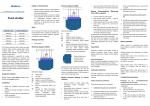
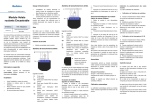
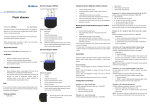
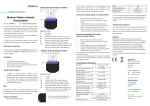

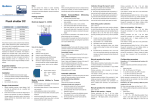

![HomeSullivan 40885B622W(3A)[BED] Instructions / Assembly](http://vs1.manualzilla.com/store/data/006934806_1-7eed6b9cc56669436b551357ae7c9d0a-150x150.png)
